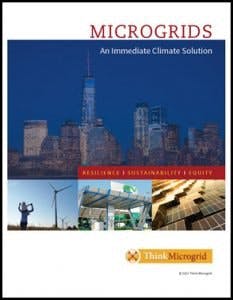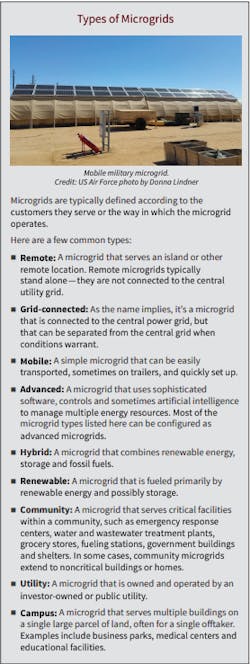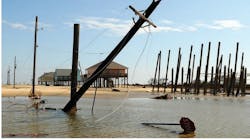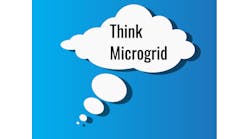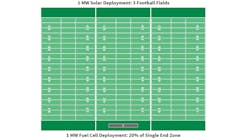In the fourth article of this special report series brought to you by Microgrid Knowledge and Think Microgrid, we’ll demonstrate why microgrids are the 21st century solution to today’s energy problems. Microgrids are local, flexible, cost effective and clean.
Read the entire vision paper.
Microgrids are proving themselves to be the energy technology of our time. A form of local energy, they keep the power flowing to nearby customers when the utility grid fails. Microgrids also help customers manage costs, gain energy prosperity and reduce carbon emissions. Microgrids provide services to the utility grid — they can be a valuable resource when the grid is strained or unbalanced.
To review: A microgrid is a self-sufficient energy system that serves a discrete geographic footprint, such as a college campus, factory, hospital complex, business center, military installation or neighborhood. Microgrids can operate independently from the grid using power generated on-site; they can also be used for backup power. Microgrids are designed to operate consistently in both “blue sky” and emergency situations supported by a range of energy resources, such as renewable energy, energy storage, combined heat and power or generators. It’s easy to know which buildings have microgrids. They are the ones lit up during grid outages, while surrounding buildings remain in the dark.
Microgrids provide flexibility through software intelligence, allowing energy to provide a range of services depending on the needs of the host customer and the electric grid as a whole. In fact, what sets a microgrid apart from other energy technologies is its ability to operate while connected to the grid and also while disconnected from the grid, based on conditions at any given moment. If a storm, wildfire or other disaster causes a grid outage, the microgrid will separate from the grid to prevent the buildings it protects from succumbing to the outage. The microgrid then serves the load itself using on-site energy resources.
But a microgrid doesn’t only protect its customers during a power outage. It also can provide grid-connected services whenever they are needed. In fact, under normal operation, the microgrid takes from the grid and gives back to the grid in a symbiotic relationship. Strategically placed microgrids can reduce strain on the electric grid, which can reduce costs and power outages that result from too much demand for electricity chasing too little supply. This happens, for example, on hot summer days when the grid is working full tilt to supply electricity for air conditioners. Businesses and communities would benefit from microgrids in such a circumstance, using locally-generated microgrid electricity instead of expensive peak energy from the utility grid, a situation that may save money while freeing up utility grid resources for others to use. Microgrids can also earn revenue by participating in demand response programs offered by utilities and grid operators. These examples speak to the locational value of microgrids — which can be built in areas where large energy facilities cannot.
Microgrids also serve local utilities by helping them manage the ever-growing number of distributed energy resources on their systems, such as solar panels, interactive buildings, electric vehicles, batteries and virtual power plants. Microgrids use advanced controllers, software and sometimes artificial intelligence that allow them to undertake sophisticated energy management operations, transforming what can be a confusion of grid inputs into an organized whole.
Advanced intelligence within a microgrid can program its generation resources to achieve specific goals, such as producing the lowest cost, most efficient or cleanest energy in response to changes in weather, wholesale price shifts or availability of sunlight, wind or fuel. A microgrid may, for example, use renewable fuels like solar to serve as a hedge in power markets to reduce the cost of electricity to its customers.
Microgrids are not one size. They are built to the needs of their offtakers, which might be a single building (sometimes referred to as a nanogrid) or something larger: a neighborhood, community, business park, college campus, medical center, critical facility, military base or any other entity that would benefit from on-site energy. And not all microgrids use the same generation resources. Solar, batteries and generators are common, but some microgrids also use fuel cells, wind power, flywheels, hydroelectricity and other forms of energy. Regardless of the technologies at play, microgrids are distinguished by their ability to operate independently, flexibly and reliably.
Microgrids are superior to backup generators
During power outages, microgrids are a more finely tuned and robust resource than conventional backup generators. Conventional generators are incapable of undertaking the sophisticated energy management that emergencies require, and they are less reliable than microgrids. Since these generators are typically used only in emergencies, operators often discover at the last minute that a given generator is broken. During Superstorm Sandy, 16% of emergency medical services organizations reported that emergency generators did not perform as expected, according to a report from the American College of Emergency Physicians. Microgrids, on the other hand, run more frequently — some run all the time — so they are constantly maintained, reducing the likelihood of an unhappy surprise during an emergency.
Advanced microgrids also typically draw from a variety of energy resources. So in an emergency, if one resource is unavailable, another can step in. For example, if a cloud prevents solar panels from providing adequate generation, the microgrid’s energy storage system can do so. If the battery is depleted, its generators can step up. This allows the microgrid to provide power indefinitely, as long as one of its generating resources can provide power. By contrast, backup generators that are not part of a microgrid lack this resource redundancy. They can fall victim to fuel shortages, especially when severe weather disrupts truck deliveries or pipelines freeze or fail.
How microgrids solve our energy problems
Given these benefits, microgrids are a crucial technology in the campaign to meet the overarching goals described at the beginning of this paper:
- Protect citizens and the economy from energy disruptions already upon us because of weather climate disasters.
- Redesign the electrical system with the future in mind, introducing cleaner energy technologies to counter even greater weather extremes in the decades to come.
- Make these changes in an equitable fashion, providing distributed clean energy — and the economic prosperity it can bring — to all communities.
Electric reliability and resilience are the top reasons microgrids are installed. Advanced microgrids provide power so seamlessly that the building experiences no disruption in power flow when the grid goes down. The lights, air conditioning and other electric appliances in the building continue to run.
Such was the case at the 700-acre Gordon Bubolz Nature Preserve in Appleton, Wisconsin, which has a microgrid that uses on-site solar, a hydrogen fuel cell, battery storage, a microturbine and a natural gas generator to power its 18,000-square-foot environmental center building. Torrential rain and wind knocked out power to about 10,000 of the preserve’s neighbors on Sept. 17, 2018. But those inside the center, protected by the microgrid, had no idea an outage had occurred until they were told. As luck would have it, members of the International Association of Electrical Inspectors happened to be on a tour of the building when this happened. “Everybody was amazed there wasn’t even a flicker at the building. The microgrid was operating up to speed, and all of these electrical contractors got to witness it,” said Don Wingate, vice president of sales, utility solutions for Schneider Electric, which worked with Faith Technologies to build the microgrid.
Community microgrids
It’s not just those in a microgrid-fitted building that benefit from their ability to provide power during severe weather and disasters. Some microgrids serve community resources, offering a place to charge phones, get hot food and seek shelter.
Perhaps the most renowned of these is Blue Lake Rancheria, a tribal community in Humboldt County, California, whose microgrid — which uses solar, battery storage and diesel backup — is credited with saving four lives in October 2019.
When the county experienced a wildfire related power shutoff, Blue Lake Rancheria opened its doors to its neighbors, including people whose lives depended on reliable electricity. Four of these neighbors needed electrical medical devices to stay alive and were invited to stay in the community’s hotel.
In addition, the tribe provided EV and cell phone charging and access to the internet for local families. It also gave Humboldt’s daily newspaper a place to publish, kept a gas station up and running and provided fuel for services outside the reservation, such as the town of Blue Lake’s municipal water system and the Mad River Fish Hatchery so it could keep pumps running to keep fish hatchlings alive.
“In all, we estimate we served about 10,000 people, about 10% of the county’s population, during the outage,” said Jana Ganion, director of sustainability and government affairs at Blue Lake Rancheria.
Because of their value, community microgrids are being built by local, state and tribal governments, school districts and utilities.
For example, Connecticut utility United Illuminating installed a microgrid at a regional high school in the town of Woodbridge to power police, fire and shelter services. The microgrid, which uses fuel cell technology, is designed to activate when the surrounding grid loses service during a storm or other event. When the fuel cell is not providing emergency power, it contributes renewable energy to the state’s power grid. The fuel cell also helps heat the high school, as waste heat from the plant’s operation is transferred to the school building’s heating system.
Ports and airports
Microgrids are increasingly being built by ports and airports to ensure safe passage of people and goods. An 11-hour power outage at the world’s busiest airport, Hartsfield-Jackson Atlanta International, underscored the need for these critical facilities to shore up their energy resilience. The December 2017 outage left scores of passengers stranded after flights were canceled and rerouted. Delta Airlines took a $40 million hit as a result.
Airports and ports that have since turned to microgrids include:
Pittsburgh International Airport in July 2021 became the first major US airport completely powered by an on-site solar energy and natural gas microgrid. This microgrid was created not only to ensure resilience but to give the airport energy independence. The 20-MW microgrid is now the primary power supply for the entire airport, including the airfield, terminals, hotel and fuel station. In a reverse of the typical microgrid/grid relationship, the grid will serve as the backup system should the microgrid fail. Peoples Natural Gas built the microgrid in partnership with other organizations including Duquesne Light, the local utility, LLI Engineering, IMG Energy Solutions, CNX Resources and EIS Solar.
The Redwood Coast Airport microgrid, a 100% renewable microgrid in Humboldt County, California, is being built by the Schatz Energy Research Center at Humboldt State University, Redwood Coast Energy Authority and Pacific Gas & Electric. It will serve both a regional airport and a US Coast Guard Air Station that runs search and rescue missions for 250 miles of rugged coastline.
The Port of San Diego is building a microgrid, scheduled for completion in late 2021, to provide resilience-specific port facilities. The microgrid, which will use solar and energy storage, is especially important because San Diego is a strategic port that provides services to the US military. The military can take over the terminal within 48 hours notice to respond to natural or man-made emergencies. Being installed by EDF Renewables, the microgrid is expected to bring $3.2 million in energy savings to the port over 20 years.
The Port of San Diego is building a microgrid, scheduled for completion in late 2021, to provide resilience-specific port facilities. Being installed by EDF Renewables, the microgrid is expected to bring $3.2 million in energy savings to the port over 20 years. — Think Microgrid, “Microgrids: An Immediate Climate Solution“
The Port of Long Beach microgrid, a Schneider Electric project, ensures a stable supply of energy using innovative features like a mobile battery that can extend the microgrid’s reach throughout the port during emergencies.
New York City’s JFK Airport has included microgrid technology in the redevelopment of its Terminal One. Another Schneider Electric project, the microgrid is expected to not only improve the terminal’s electric reliability, but also reduce the total amount of fuel required to operate the terminal by as much as 30% and contribute to the airport’s goal of reaching 100% renewable energy usage within the next decade.
To read about additional microgrids, including those that serve grocery stores, health care, utilities and the military, read the full vision paper, courtesy of Think Microgrid. If you feel that microgrids need a unified voice in regulatory and policy discussion, please join Think Microgrid. Learn more about becoming a member of Think Microgrid.
Next week, we’ll conclude our series by looking at:
- How to Capture the Full Benefits of Microgrids in Climate Change Strategies and Infrastructure Plans.

